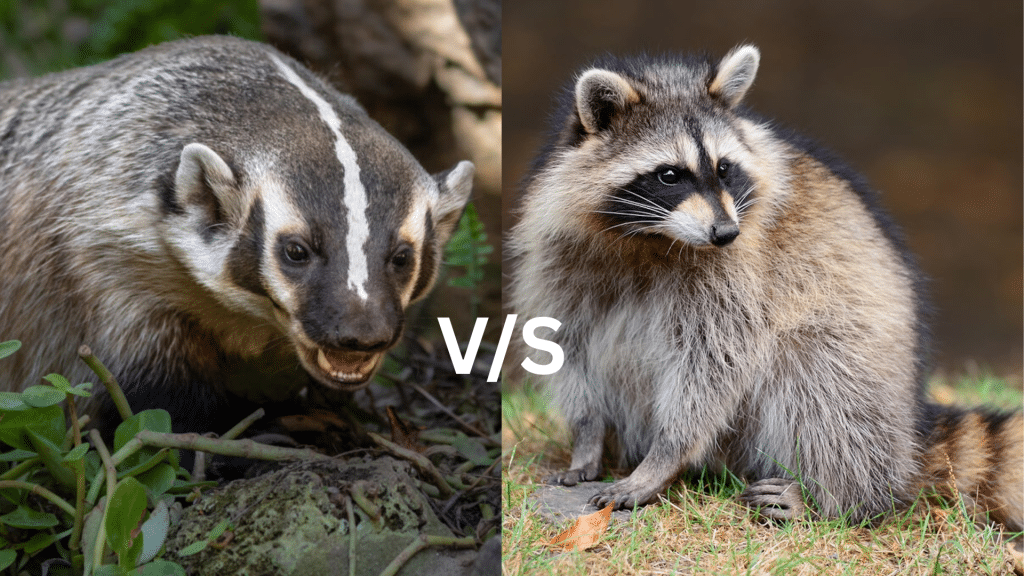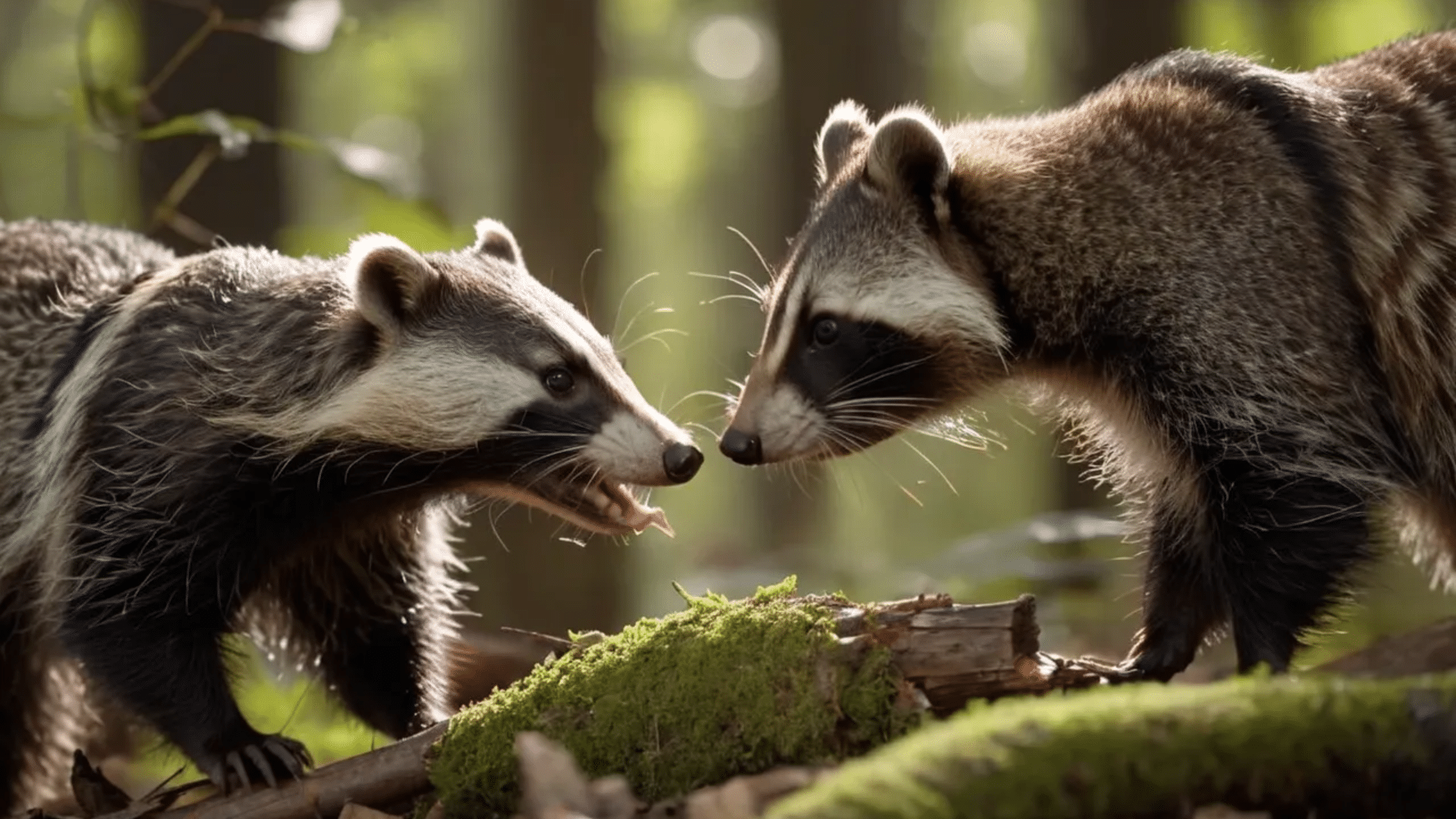Both badgers and raccoons hold a place in the forests and fields as clever mammals with strong skills. These masked bandits share some traits but differ in key ways, making each unique.
Raccoons show off their hand-like paws and smart problem-solving, while badgers stand out with their digging skills and bold nature.
When these two species meet in the wild, their interactions reveal much about how animals adapt to their environments.
This post looks at what makes each animal special, their behavior and lifestyle patterns, and certain similarities between the two.
Physical Characteristics
Badgers and raccoons differ significantly in their appearance and physical characteristics.
- Raccoons have a medium-sized frame with a stout body and short legs. Their famous black mask and ringed tail make them easy to spot.
- Badgers show a flatter, wider build with short but strong legs made for dirt work. The white stripe on a badger’s face runs from nose to neck, clear against dark fur. Their coats serve as shields from cold and wet.
Each has tools that help them find food – raccoons use nimble front paws while badgers have long claws for digging.
These traits enable each to thrive in their chosen environment, from forests to fields. Their body plans are well-suited to their respective lifestyles.
1. Size and Build
These two mammals exhibit distinct size differences. Badgers weigh more and have a lower, wider frame. Raccoons stand taller with a more cat-like shape and carry less weight.
| FEATURE | BADGER | RACCOON |
|---|---|---|
| Weight | 15-25 pounds | 10-20 pounds |
| Length | 25-35 inches | 24-38 inches |
| Height | 10-12 inches | 12-18 inches |
| Body Type | Low, flat, wide | Medium height, rounded |
2. Appearance
Both have marks that help folks tell them apart. Their fur colors and facial markings make each type stand out from other wild mammals in their respective areas.
| FEATURE | BADGER | RACCOON |
|---|---|---|
| Fur Color | Gray to brown | Gray to brown |
| Face Markings | White stripe down the middle | Black mask around eyes |
| Tail | Short, same color as the body | Long with black rings |
| Ears | Small, rounded | Pointed |
Behavior and Lifestyle
Badgers and raccoons lead quite different lives in the wild. Badgers spend most of their time underground in tunnel systems they dig with their strong claws.
Raccoons, on the other hand, prefer life above ground and often climb trees for safety. Both animals show clever thinking, but they use their smarts in different ways.
Badgers tend to be solo creatures who meet others mainly to mate. Raccoons show more social traits, with mothers and young staying as a group for up to a year.
Their daily routines match their body features and food needs.
Daily Habits
- Badgers: Most active during dawn and dusk hours
- Raccoons: True night animals who rest when the sun is up
- Sleep patterns: Badgers may rest for days during cold spells, but don’t fully sleep through winter
- Movement: Raccoons wander more each night than badgers do
Eating Habits of a Badger
- Small ground mammals like mice and voles
- Worms and grubs dig from the soil
- Ground nests of bees and wasps
- Small snakes and frogs, when found
Eating Habits of a Raccoon
- Nuts, fruits, and berries from plants
- Crayfish and frogs from the water edges
- Bird eggs taken from nests
- Food scraps found near human homes
Similarities Between a Badger and a Raccoon
While badgers vs raccoons differ in many ways, they share several traits that help them thrive in their natural homes. These common points show why both animals do well across many places.
- Both are medium-sized mammals that fall into the same general weight range of 10-25 pounds.
- Each shows strong problem-solving skills and can remember solutions to tasks they faced before.
- Both can adapt to living near people and often do well despite changes to their natural homes.
- Each eats varied foods, including both plants and small animals, switching choices as seasons change.
- Both will dig when looking for food or making shelter, though badgers are much more skilled diggers.
- Each uses keen senses, especially their strong sense of smell, to locate food that is hidden from sight.
Who is Better Between a Badger and a Raccoon?
There is no clear winner when comparing badgers and raccoons. Each animal fits perfectly into its own space in nature.
- Badgers excel at digging and hunting small ground animals. Their strong bodies and determined nature make them masters of the underground world.
- Raccoons win with their smart hands and quick thinking, which helps them solve new problems. Both play key roles in their habitats by controlling pest numbers and spreading plant seeds.
The question of which is “better” makes as much sense as asking whether a hammer is better than a screwdriver.
Each has special skills for its tasks. The true answer depends on which traits a person values more: strength or clever thinking.
Summing It Up
Badgers and raccoons show nature’s range in creating mammals that succeed in very different ways. These animals may share some traits, but their paths in life rarely cross.
Badgers stay low and dig deep, while raccoons climb high and wander widely. Their body shapes, homes, and habits all fit their unique ways of living.
So what does this mean for people who spot these animals? Understanding badger vs raccoon helps us see how each fits into the local web of life.
Both play and roles are needed in keeping nature healthy.
See one in your yard? Keep a safe distance and enjoy the chance to watch them work.





















